Best day, every day: Kaydee’s NICU-to-Now story
Meet Kaydee
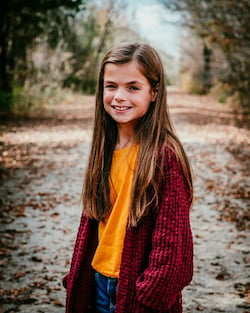
10-year-old Kaydee gets more done in 24 hours than most adults. First, she does morning farm chores on the cow-calf operation her dad, Trevor, and mom, Kaylee, run. Then homeschooling; being a big sister to 4-year-old Maycee; riding practice; working with her agility dog, Chloe; and checking the cattle again in the evening.
“We squeeze every minute out of every day,” said Kaylee, now a Patient and Family Engagement Specialist at Children’s Mercy Kansas City.
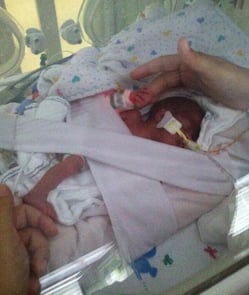
A very early start
You could say this in-the-middle-of-everything kid was ready to go from the beginning: Kaydee was born at 25 weeks and two days gestation after an emergency C-section.
“Her lungs were very underdeveloped, and so we just had to take it day by day, sometimes hour by hour, sometimes minute by minute,” said Kaylee.
But Kaydee was 1 pound and 6 ounces of determination. Kaydee spent four months at her birth hospital’s Level 3 NICU until she required more services than they could provide.
“It was very challenging in the beginning because her bronchopulmonary dysplasia (BPD) was pretty severe,” said Winston Manimtim, MD, Director of the Infant Tracheostomy and Home Ventilator Program at Children’s Mercy. Kaydee developed BPD, a chronic lung disease where fragile, newborn lungs are damaged by the very oxygen therapies and mechanical ventilation they need to survive.
“[The other NICU] did a really good job supporting her in the early months of her life, but we are the only place in Kansas City that can provide tracheostomy care and long-term home ventilation for kids like Kaydee,” said Dr. Manimtim.
“Hurry up and wait and grow”
A few years before Kaydee was born, the Level IV NICU at Children’s Mercy organized the Chronic Lung Disease (CLD) team, dedicated to providing multidisciplinary care to preterm infants with BPD like Kaydee. After thorough evaluation of Kaydee’s condition, it became clear that she would need long-term assisted ventilation at home. To do this, she would need a tracheostomy, a surgery that makes a hole in the windpipe to create an alternate breathing pathway that can be connected to a mechanical ventilator. They also gave Kaydee a G-tube so she could get the nutrition she needed.
“Then it was just hurry up and wait and grow,” said Kaylee. She remembered how developing relationships with Kaydee’s doctors and nurses — and having a care conference meeting with the team every other week — helped them feel comfortable in their new hospital home.
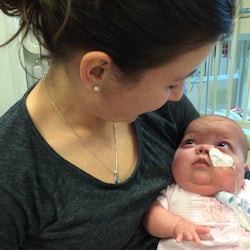
Equipping parents for home trach care
Our CLD team, with its direct link to our outpatient Infant Tracheostomy and Home Ventilator Program, has a customized approach to helping patients transition from ICU ventilators to home ventilators, which are more portable but less powerful. Once patients are stable on an ICU ventilator, the team starts working on lowering the level of ventilator support until they can get an equivalent setting on a home ventilator.
“Our practice has been to slowly transition to the home ventilator and let our patients guide us during the transition process,” said Dr. Manimtim.
“As Kaydee was getting used to being on the home ventilator, Kaylee and Trevor were learning how to do trach changes and cares, how to clear secretions and how to handle emergency scenarios,” said Addie Begley, RN, MSN, NNP-BC, a neonatal nurse practitioner on the Home Ventilator team.
Families train for up to several months until they are comfortable with all aspects of home ventilation procedures. Before they leave the hospital, they do a 48-hour patient care stay to practice their skills on-site with the team’s supervision.
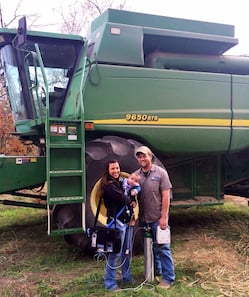
“We want to make sure they feel comfortable and confident going home,” said Addie. “Living on a farm, it would take EMS quite a while to get to Kaydee’s home if they needed to call them, so they really had to know their stuff.”
At nine months, Kaydee was finally strong enough for the journey back to the ranch. Her parents were prepared as well.
“We were so ready to be home and figure out what life is going to be like, but at the same time we were terrified,” said Kaylee.
But they didn’t have to face that fear alone. In addition to in-home nursing and therapies, the Infant Home Ventilator program was a phone call away, all day, every day for questions and emergent situations.
“We want to make sure they feel well-supported,” said Addie. "The developmental and social progress patients make after they go home is incredible. That’s why we do this! Patients just thrive at home.”
“The team was phenomenal and available to me 24/7,” said Kaylee. “Kaydee's success is completely, utterly attributed to how they supported us.”
The team returned the compliment, crediting Kaylee and Trevor’s ability to create as normal a life as possible for Kaydee when they returned home. (Even if Dr. Manimtim sometimes got nervous seeing pictures of a toddler Kaydee with the cows, ventilator in tow!)
“You could not have wished for better parents as caregivers,” said Dr. Manimtim. “This is just a model family; she was participating in every activity they had.”
Unstoppable Kaydee
Kaydee had her tracheostomy removed right before her fourth birthday and has been breathing on her own ever since.
“Kaydee has always been this little spark of fire,” said Addie. “She lives like every day is the best day ever. She’s been like that since she was a baby!”
Kaydee continues to see the Endocrinology; Gastroenterology; Ear, Nose and Throat; and Pulmonology teams at Children’s Mercy and has outside speech and occupational therapy as well. She’s been making progress on her speech delays and recently gave a project talk at her 4-H club.
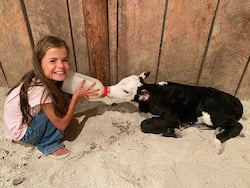
“As she's getting older, she has outgrown a lot of the medical problems that she had when she was little,” said Hugo Escobar, MD, Kaydee’s pulmonologist and longest-running team member. “Her airways are larger, so it's easier for her to breathe and manage viral infections. She’ll have some limitations on intense exercise, but other than that, we expect that she can have a very normal life. She’s a hard-working young lady. She doesn’t let anything stop her!”
